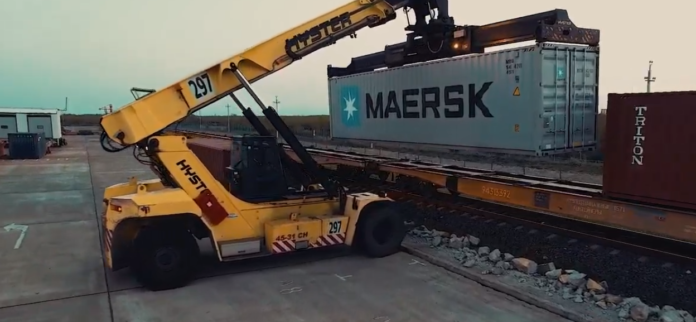
-
Maersk opens new China-Europe rail link
-
Over-90% electrified rail service connects customers in China and Europe via Central Asia, the Caucasus and Transylvania
-
Maersk says the revamped service helps ease current logistics woes. These issues obviously stem from the Russian invasion of Ukraine
-
The group is also extending the temporary omission of one of its two port calls at Trieste from the loop due to port congestion and ship arrival delays
A.P. Moeller-Maersk has opened a revamped China-Europe rail link that connects customers in China and Europe via Central Asia, the Caucasus and Transylvania, the company said in a statement on May 16.
The new Middle Corridor rail-barge service departs from various locations in China and travels to Europe via Kazakhstan, Azerbaijan, Georgia, and Romania on more than 90% electrified tracks in about 40 days, the Copenhagen-based company said.
“Aiming to create agile and creative solutions to our evolving customers’ needs, this revamped service comes at the perfect time to help ease current logistics woes,” said Maia Parlagashvili, Maersk global product manager for Intercontinental Rail at Maersk.
“We have listened to our customers and developed a solution that provides them an alternative and eco-friendly intermodal connection between Asia and Europe. Over 90% of the Middle Corridor rail service is electrified.”
After passing through the border of Khorgos between China and Kazakhstan, containers arrive by rail to the station of Aktau where they are loaded on a barge to Baku in Azerbaijan, she said.
From there, the containers are railed to APM Terminals Poti in Georgia, where they are loaded on a feeder vessel to Constanta, Romania. From Poti, the cargo is transported by rail to various destinations across European countries.
Until February this year, 80% to 90% of trade from China to Western Europe passed through the Northern Corridor through the Baltic Sea ports.
Just days before Russia invaded Ukraine on February 24, Maersk announced its AE66 sea-rail-sea service had become fully operational. The new service linked Korea, Japan and China to the Kaliningrad Region in Russia, the Baltic countries, and Poland through the Trans-Siberian line.
Nothing has been heard about the sea-rail-sea service that used to depart from Vostochniy port in the Russian Far East on the Pacific coast to Kaliningrad on the Baltic Sea since Maersk’s exit in April from Russia and Belarus for the safety of its staff due to the Ukraine war.
Maersk started developing this new route back in March and had the first departure from China in April, serving customers from lifestyle, automotive and household appliances industries.
“The Corridor has sufficient open capacity, allowing our customers to strengthen their supply chain resilience by having an alternative route to ocean and air services,” Parlagashvili said.
Maersk, the second-largest global container line, also advised customers it is extending through July its rationalized AE12 service that omits one of two normal port calls at Trieste due to ongoing bottlenecks caused by port congestion and late arrival of vessels.
“We are continuing this contingency measure to protect schedule reliability on the AE12 service and to give our customers better predictability and visibility on their shipments,” the group said.
Contingency Rotation: Xingang – Dalian – Busan – Ningbo – Shanghai – Shekou – Singapore – Port Said – Haifa – Koper – Trieste – Rijeka – (Trieste omitted) – Port Said – King Abdullah – Salalah – Singapore – Xingang.
Maersk said as the situation evolves, the group is working closely with all stakeholders in the local supply chain to help mitigate its effects. It assured customers the measure is temporary and aims to minimize supply chain delays and alleviate the impact on their businesses.




